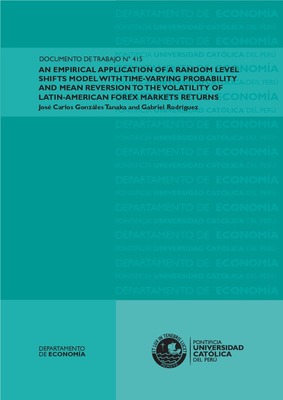| dc.contributor.author | Gonzáles Tanaka, José Carlos | |
| dc.date.accessioned | 2018-06-28T15:17:01Z | |
| dc.date.available | 2018-06-28T15:17:01Z | |
| dc.date.issued | 2016-03 | |
| dc.identifier.uri | http://repositorio.pucp.edu.pe/index/handle/123456789/126748 | |
| dc.description.abstract | Following Xu and Perron (2014), this paper uses daily data for six Forex Latin American markets. Four models of the family of the Random Level Shift (RLS) model are estimated: a basic model where probabilities of level shift are driven by a Bernouilli variable but probability is constant; a model where varying probabilities are allowed and introduced via past extreme returns; a model with mean reversion mechanism; and a model incorporating these two features. Our results prove three striking features: first, the four RLS models fit well the data, with almost all the estimates highly significant; second, the long memory property disappears completely from the ACF, including the GARCH effects; and third, the forecasting performance is much better for the RLS models against an overall of four competitor models: GARCH, FIGARCH and two ARFIMA models.
Siguiendo el trabajo de Xu y Perron (2014), este documento utiliza datos diarios de volatilidades de retornos cambiarios para seis mercados de América Latina. Cuatro modelos del tipo Random Level Shifts (RLS) son estimados: un modelo básico donde las probabilidades de cambios de nivel son gobernadas por una variable del tipo Bernouilli pero dicha probabilidad es constante; un modelo donde las probabilidades son cambiantes en el tiempo y dependen de los retornos bursátiles extremos negativos del periodo anterior; un modelo con reversión a la media; y un modelo que incorpora los dos aspectos mencionados anteriormente. Los resultados sugieren tres importantes aspectos: el primero es que los cuatro modelos RLS ajustan bien los datos con prácticamente todos los estimados altamente significativos; segundo, la característica de larga memoria desaparece completamente de la ACF, incluyendo los efectos GARCH; y, tercero, la performance de los cuatro modelos en términos de predicción es buena contra diferentes modelos rivales como los modelos GARCH, FIGARCH, y dos modelos ARFIMA. | en_US |
| dc.language.iso | spa | es_ES |
| dc.publisher | Pontificia Universidad Católica del Perú. Departamento de Economía | es_ES |
| dc.relation.ispartof | urn:issn:2079-8466 | |
| dc.relation.ispartof | urn:issn:2079-8474 | |
| dc.rights | Atribución-NoComercial-SinDerivadas 2.5 Perú | * |
| dc.rights | info:eu-repo/semantics/openAccess | es_ES |
| dc.rights.uri | http://creativecommons.org/licenses/by-nc-nd/2.5/pe/ | es_ES |
| dc.subject | Forecasting | es_ES |
| dc.subject | Forex Return Volatility | es_ES |
| dc.subject | Latin American Forex Markets | es_ES |
| dc.subject | Long memory | es_ES |
| dc.subject | Mean Reversion | es_ES |
| dc.subject | Random Level Shifts | es_ES |
| dc.subject | Time Varying Probability | es_ES |
| dc.title | An Empirical Application of a Random Level Shifts Model with Time-Varying Probability and Mean Reversion to the Volatility of Latin-American Forex Markets Returns | es_ES |
| dc.type | info:eu-repo/semantics/workingPaper | |
| dc.type.other | Documento de trabajo | |
| dc.subject.ocde | http://purl.org/pe-repo/ocde/ford#5.02.00 | |
| dc.publisher.country | PE | |


